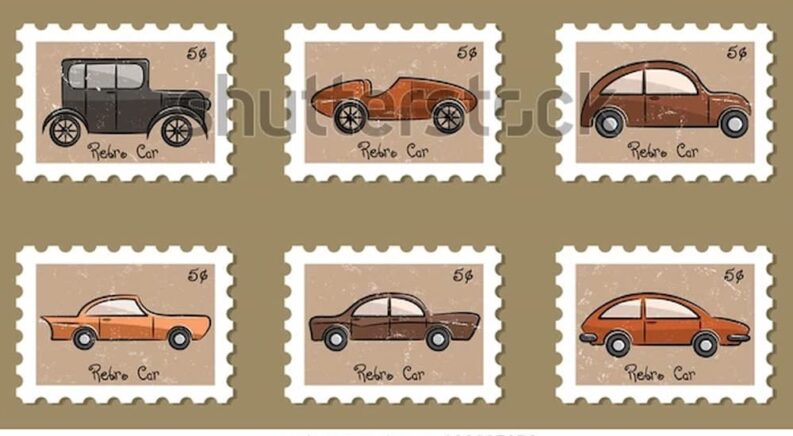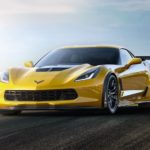I’m not sure how large the overlap might be in the Venn diagram of “car fans” and “stamp collectors,” but even if it’s not very big, I still think there are plenty of us who can appreciate some nice car-related artwork. If that artwork happens to be on something functional, like a postage stamp, then that’s even better—which is exactly what makes the recent issuance of stamps from the United States Postal Service (USPS) celebrating pony cars so attractive.
While I’m certainly not a stamp aficionado—philatelist (noun): someone who studies or collects stamps—I can appreciate what the USPS has done with these, and I thought it would be fun to take a look at the five different models that they chose to celebrate and highlight as quintessential examples of American performance.
The 1969 Ford Mustang Boss 302
Not surprising in the least. Here we have the clearest example of the pony car design: the Ford Mustang. (We’ll look at the specific model they chose in a moment.) First introduced in 1964, the Mustang immediately became an iconic part of the American automotive landscape. Ford had hoped to sell 100,000 Mustangs in their first year; they sold that many within three months and ended up selling more than 400,000 within the first 12 months of the Mustang’s release. In the decades since its launch, it’s remained a mainstay of performance and generally stayed true to its design.
For the stamp collection, the USPS specifically chose the 1969 Ford Mustang Boss 302, which is a model noteworthy for delivering incredible performance and style. Two Boss models of the Mustang were available for 1969 and 1970: the 302 featured a 302 cu.in. (or 5.0L) V8 engine, while the beefier Mustang Boss 429 used a 429 cu.in. (7.0L) V8. To set itself apart from other Mustang models, the powerful Boss 302 featured a more aggressive look, with a matte black center hood and front grille. It was offered only as a fastback coupe rather than as a convertible and helped reestablish the Mustang as a leader not only in looks but in power and speed.

The 1970 Dodge Challenger R/T
Although the Ford Mustang might be what a lot of people immediately think of when they hear “pony car,” few models represented this concept quite as well as the Dodge Challenger. First introduced for the 1970 model year, the Challenger was developed by Dodge to be a direct competitor with models from other companies like the Mustang and the Mercury Cougar (more on that below). As such, the name “Challenger” seems truly apt, and it quickly proved accurate as this Dodge beast was available in a wide range of options and with a number of incredible engines designed to make driving incredibly rewarding.
For many fans, this model is the purest example of what the Challenger had to offer—the first model year, before any facelifts or other changes. The R/T was the performance-focused variant of this inaugural model, featuring a 383 cu.in. (6.3L) V8 engine that delivered 335 hp, compared to the 225 cu.in. straight-six in the standard Challenger. It was offered either with a hardtop or as a drop-top convertible, though the hardtop was the more popular option. Despite this fact, the Dodge Challenger R/T on the stamp appears to be a drop-top model, albeit with its top up. I’d wager this is due to convertibles becoming fan favorites as years went by and people realized what they had missed.
The 1969 Chevrolet Camaro Z/28
Now we come to a personal favorite of mine, the Chevy Camaro, which is the perfect example of a car company realizing it can appeal to two related but separate niche markets. Despite Chevy offering the sporty Corvette since 1953, they released the Camaro in 1966 as a direct competitor to the Ford Mustang. And when I say direct, I mean that when Chevy was asked what a “Camaro” was, they responded that it was a “small, vicious animal that eats Mustangs.” That’s about as direct a shot at a competitor as you’re likely to ever see and it pretty well set the tone for what this pony car was meant to do.
For the stamp, the USPS chose a model from the end of its first generation, the 1969 Camaro Z/28, rather than the inaugural model year. Much like with the Boss 302 and the Challenger R/T, the Camaro Z/28 was a performance-focused version that featured a high-output 302 cu.in. V8 engine and power disc brakes to help slow it down once it got going. It’s no coincidence that this sounds a lot like the engine in the Mustang Boss 302, as the Camaro Z/28 was designed to directly compete with it as a track-ready pony car that people could enjoy on the street.
The 1967 Mercury Cougar XR-7 GT
Now we come to the aforementioned Mercury Cougar—a name that’s no longer a part of the automotive landscape but one that was quite important for many years. Mercury was a division of Ford, offering more options for car buyers at the time, and the Cougar was developed specifically to offer another pony car choice other than the Mustang. That being said, it clearly took its design cues and engineering from the Mustang—which isn’t a bad thing at all. Higher-ups at Ford were initially unsure about developing the Cougar, but after the incredible success of the Mustang, they were quick to give Mercury the go-ahead, and the Cougar hit the road in 1966.
The 1967 Mercury Cougar shared a chassis with the Mustang of the same year, though it had a longer wheelbase and used engineering from the Ford Falcon. For their stamp, the USPS has chosen a Cougar model with all of the bells and whistles, plus an incredibly impressive engine. The XR-7 designation indicates a model with all the options, which ran almost double the price of the base Cougar, while GT means it came with a 390 cu.in. V8 engine, plus an upgraded suspension, boosted exhaust system, and larger wheels and tires to really amp up performance.
The 1969 AMC Javelin SST
Mercury isn’t the only company that’s no longer with us yet appears on one of these stamps; the AMC Javelin is a name that’s not nearly as well known these days as the Mustang, but it’s still worthy of its place in the halls of pony car legend. The American Motors Corporation (AMC) was a major player in the US auto scene starting in the 1950s and going through the 1980s when it was bought and merged into Chrysler. AMC introduced the Javelin in 1967 as a direct competitor for models from the Big Three like the Camaro, Mustang, and Cougar.
The 1969 Javelin was a gorgeous piece of machinery, and it’s great to see the USPS giving some love to a model that’s easily overlooked by modern drivers. Rather than trying to offer something for everyone, the Javelin was available only as a two-door with a hardtop, though the SST here was the premium model with more packed into it than the base trim. We’ll assume that the one portrayed by Tom Fritz—the artist of these stamps—features the available 390 cu.in. V8 engine that delivers 315 hp, making it a solid competitor for the big boys we’ve looked at so far.
A Sign of the Times
I think this is an interesting selection of pony cars chosen by the USPS, both in terms of the particular models they went with as well as some specific packages and trims. To me, it shows a real love for what pony cars represent and the kind of driving experience they’ve offered for decades—something no other type of vehicle can really capture.
It will be interesting to see if pony cars can retain—or perhaps reclaim—a meaningful place in the auto industry and car market, perhaps with a wave of all-electric models to reinvigorate these beasts. I can’t help but smile at the idea of zero-emission Challenger, Mustang, and Camaro models prowling the streets, with vintage looks and throw-back styling combined with modern engineering. With any luck, fifty years from now we’ll see a series of stamps celebrating the rebirth of pony cars and a new collection of vehicles that continued their tradition of performance and style.




